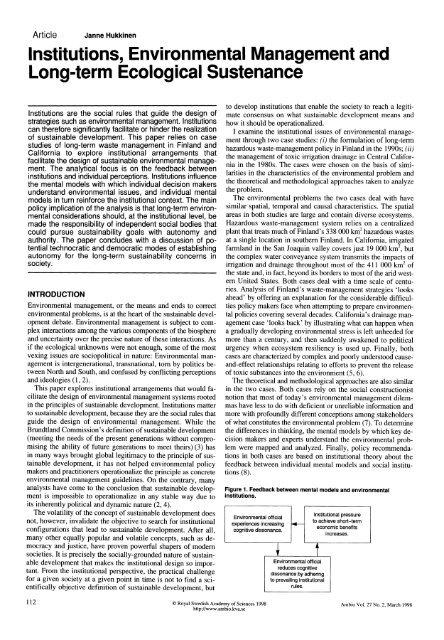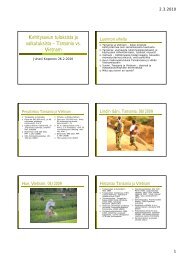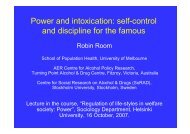ArticleJanne HukkinenInstitutions, Environmental Management andLong-term Ecological SustenanceInstitutions are the social rules that guide the design ofstrategies such as environmental management. Institutionscan therefore significantly facilitate or hinder the realizationof sustainable development. This paper relies on casestudies of long-term waste management in Finland andCalifornia to explore institutional arrangements thatfacilitate the design of sustainable environmental management.The analytical focus is on the feedback betweeninstitutions and individual perceptions. Institutions influencethe mental models with which individual decision makersunderstand environmental issues, and individual mentalmodels in turn reinforce the institutional context. The mainpolicy implication of the analysis is that long-term environmentalconsiderations should, at the institutional level, bemade the responsibility of independent social bodies thatcould pursue sustainability goals with autonomy andauthority. The paper concludes with a discussion of potentialtechnocratic and democratic modes of establishingautonomy for the long-term sustainability concerns insociety.INTRODUCTIONEnvironmental management, or the means and ends to correctenvironmental problems, is at the heart of the sustainable developmentdebate. Environmental management is subject to complexinteractions among the various components of the biosphereand uncertainty over the precise nature of these interactions. Asif the ecological unknowns were not enough, some of the mostvexing issues are sociopolitical in nature: Environmental managementis intergenerational, transnational, torn by politics between<strong>No</strong>rth and South, and confused by conflicting perceptionsand ideologies (1, 2).This paper explores institutional arrangements that would facilitatethe design of environmental management systems rootedin the principles of sustainable development. Institutions matterto sustainable development, because they are the social rules thatguide the design of environmental management. While theBrundtland Commission's definition of sustainable development(meeting the needs of the present generations without compromisingthe ability of future generations to meet theirs) (3) hasin many ways brought global legitimacy to the principle of sustainabledevelopment, it has not helped environmental policymakers and practitioners operationalize the principle as concreteenvironmental management guidelines. On the contrary, manyanalysts have come to the conclusion that sustainable developmentis impossible to operationalize in any stable way due toits inherently political and dynamic nature (2, 4).The volatility of the concept of sustainable development doesnot, however, invalidate the objective to search for institutionalconfigurations that lead to sustainable development. After all,many other equally popular and volatile concepts, such as democracyand justice, have proven powerful shapers of modemsocieties. It is precisely the socially-grounded nature of sustainabledevelopment that makes the institutional design so important.From the institutional perspective, the practical challengefor a given society at a given point in time is not to find a scientificallyobjective definition of sustainable development, butto develop institutions that enable the society to reach a legitimateconsensus on what sustainable development means andhow it should be operationalized.I examine the institutional issues of environmental managementthrough two case studies: (i) the formulation of long-termhazardous waste-management policy in Finland in the 1990s; (ii)the management of toxic irrigation drainage in Central Californiain the 1980s. The cases were chosen on the basis of similaritiesin the characteristics of the environmental problem andthe theoretical and methodological a<strong>pp</strong>roaches taken to analyzethe problem.The environmental problems the two cases deal with havesimilar spatial, temporal and causal characteristics. The spatialareas in both studies are large and contain diverse ecosystems.Hazardous waste-management system relies on a centralizedplant that treats much of Finland's 338 000 km2 hazardous wastesat a single location in southern Finland. In California, irrigatedfarmland in the San Joaquin valley covers just 19 000 km2, butthe complex water conveyance system transmits the impacts ofirrigation and drainage throughout most of the 411 000 km2 ofthe state and, in fact, beyond its borders to most of the arid westernUnited States. Both cases deal with a time scale of centu-ries. Analysis of Finland's waste-management strategies 'looksahead' by offering an explanation for the considerable difficultiespolicy makers face when attempting to prepare environmentalpolicies covering several decades. California's drainage managementcase 'looks back' by illustrating what can ha<strong>pp</strong>en whena gradually developing environmental stress is left unheeded formore than a century, and then suddenly awakened to politicalurgency when ecosystem resiliency is used up. Finally, bothcases are characterized by complex and poorly understood causeand-effectrelationships relating to efforts to prevent the releaseof toxic substances into the environment (5, 6).The theoretical and methodological a<strong>pp</strong>roaches are also similarin the two cases. Both cases rely on the social constructionistnotion that most of today's environmental management dilemmashave less to do with deficient or unreliable information andmore with profoundly different conceptions among stakeholdersof what constitutes the environmental problem (7). To determinethe differences in thinking, the mental models by which key decisionmakers and experts understand the environmental problemwere ma<strong>pp</strong>ed and analyzed. Finally, policy recommendationsin both cases are based on institutional theory about thefeedback between individual mental models and social institutions(8).Figure 1. Feedback between mental models and environmentalinstitutions.Environmental officialexperiences increasig .tocognitive dissonance.Environmental officialreduces cognitivedissonance by adheringto prevailing institutionalrules.Institutional pressureachieve short-termeconomic benefitsincreases.<strong>112</strong> ? Royal Swedish Academy of Sciences 1998 <strong>Ambio</strong> <strong>Vol</strong>. <strong>27</strong> <strong>No</strong>. 2, March 1998http://www.ambio.kva.se
I introduce some of the institutional economic concepts theanalysis relies on. The reader should keep in mind that the mainpurpose is to illustrate the dynamics between institutions and individualperceptions in long-term and large-scale environmentalmanagement. However, since the two cases represent quitedifferent sociopolitical and cultural contexts, yet converge ontheir broad institutional characteristics, one should look for similardynamics in other large-scale environmental managementsystems (9). According to the cases, the absence of institutionsthat would allow autonomous social agents to decide on longtermenvironmental management has committed western indus-trialized countries to an industrial production system incapableof ecological restructuring and waste prevention.MENTAL MODELS AND INSTITUTIONS OFENVIRONMENTAL MANAGEMENT<strong>No</strong>rth (8) explains the society as a game played by social organizationsaccording to the rules stipulated by institutions, bothformal (such as laws and regulations) and informal (such asnorms, customs and habits) (8). Organizations devise plans, policiesand strategies to survive or win in the game. To a neoclassicaleconomist, the outcome of the game is determined by playerpreferences and market forces. In light of historical evidence,however, institutions determine how freely individual economicactors can express their own views, which may result in verydifferent outcomes to the game from those predicted by neoclassicaleconomics and public choice theory alone. Institutions persistdue to a lock-in, or reinforcing feedback, between them andindividual perceptions. The institutional framework determineswhat organizations come into existence and how they evolve,but the perceptions of individuals working in the organizationsalso influence how the institutional framework evolves (Fig. 1).The two cases described illustrate the feedback between institutionsand perceptions. The policy makers interviewed, frequentlyexpressed the need to take into account the long-termfuture in environmental management, but the institutional frameworkwithin which they operated was a disincentive for them todevelop and implement environmentally sustainable policies.Increasing returns on initial resource commitment in environmentaltechnology and the complexity and uncertainty of longtermenvironmental issues reinforce the short-run oriented institutionalcontext. While the specific policy outcomes differ in thetwo cases, the cognitive structure that the policy makers and expertsshare is cognitive dissonance, i.e. an inconsistency betweenindividual decision makers' goals (policies they think shouldguide decisions) and operating assumptions (policies they thinkwill guide decisions) (10).In the two cases, cognitive dissonance takes the form of a tensionbetween goals emphasizing long-term ecological sustenanceand operating assumptions aiming at short-term economic profit.Cognitive dissonance is not merely the occurrence of conflictbetween the values of an individual official and the values onwhich the policy of the agency employing the official is based.It is rather a conflict between two very different knowledges thatthe official holds about him/herself and his/her surroundings:One relating to the state of affairs the official would like toachieve in the social game, the other to what the official considersachievable in the game under existing constraints. As thetheory on cognitive dissonance would predict, the profit-orientedoperating assumptions that dominate both the Finnish and Californiansocieties exert large enough pressure on the official topersuade him/her to reduce the dissonance by deciding on thebasis of short-term economic considerations (10). Put it anotherway, the price-be it in the form of diminished prestige or lostposition-that the individual official would have to pay for decidingaccording to his/her honest professional beliefs is too highIO\Acting in accordance with the predominant assumptions of thesurrounding society does not, however, erase the cognitive dissonancethe official experiences. Quite the o<strong>pp</strong>osite, it exacerbatesthe conflict between what the official believes in and whathe/she knows to be the necessary course of action. The cognitivedissonance individual decision makers experience and theprofit-oriented institutions surrounding them are thus in a mutuallyreinforcing feedback. The stronger the pressure that institutionsput on an individual decision maker to achieve shorttermeconomic benefits, the more pronounced the cognitive dissonancethe decision maker experiences; but the more pronouncedthe cognitive dissonance, the stronger the individual'sneed to reduce the dissonance by adhering to the prevailing institutionalrules (Fig. 1).INSTITUTIONAL OBSTACLES TO LONG-TERMECOLOGICAL SUSTENANCEHazardous Waste in Finland and the Social Steering ofEnvironmental ManagementFinland's hazardous waste-management problems have much todo with the country's large land area and small population, whichhave resulted in many small landfills (a total of 680 in 1990).Many have been closed down, but this has not diminished concernsthat the closed landfills may in fact be environmental crisesin the making as a result of hazardous wastes received dur-ing the country's rapid industrialization since the 1950s (11). Thesituation improved considerably in 1984 when the nation's centralizedhazardous waste-management plant, Ekokem, began itsoperations. When this case study was conducted in the early1990s, a total of 233 000 tonnes of hazardous waste was generatedin Finnish industry, of which a<strong>pp</strong>roximately 100000 tonneswere recycled as raw material, 90 000 treated at wastewater-treatmentplants and 43 000 treated or stored otherwise. Of the 43000 tonnes, 52% ended up at Ekokem (12).The case example on Finnish hazardous waste managementcomes from a larger study conducted from 1991 to 1993 on waysto improve the capacity of Finnish policy makers to design andimplement long-term waste-management strategies (13, 14). Thestudy focused on scenarios, or mental models, with which 24decision makers and experts on Finnish waste management rationalizetheir long-term decisions. Individual mental modelswere treated as equal elements of a collective and often internallyinconsistent model of the future. Analysis of the factual,attitudinal and logical inconsistencies in the mental models indicateshow institutions constrain policy decisions and what institutionalchanges might enable policy makers to better preparefor the long-term future (15).The interviewees described what they believed to be futurewaste-management problems in complex narratives characterizedby numerous cause-and-effect relationships. For analytical purposes,the causal dependencies between problems were codedas directed node-and-link graphs. <strong>No</strong>des in the graph are problemstatements, or sentences describing a future waste manage-ment problem. Links represent those parts of a narrative that indicatea causal relationship between two problem statements (16,17). Network representation makes explicit the linkages thatmight easily be overlooked in the narratives and allows the analystto consider the implications of several individual mentalmodels in the aggregate. The interviewees disagreed over whatthey believed to be central waste-management challenges in thefuture. <strong>No</strong> less than 282 different problem statements were identifiedin the 24 interviews.The Finnish case illustrates problems that arise when the regulationand implementation of environmental management areconfused. The Ministry of the Environment in Finland is thechief regulator of the nation's hazardous waste management, but<strong>Ambio</strong> <strong>Vol</strong>. <strong>27</strong>, <strong>No</strong>. 2 March 1998 ? Royal Swedish Academy of Sciences 1998 113http://www.ambio.kva.se
















